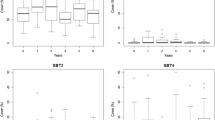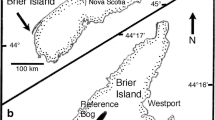Abstract
Fen meadow habitats host many rare bryophytes. Lack of management has resulted in eliminations of specialized fen bryophytes by competitively stronger vascular plants or common bryophytes. We studied the effects of management (mowing only or in combination with disturbance and litter removal) on three fen moss species, Breidleria pratensis, Sphagnum warnstorfii and Tomentypnum nitens. Experimental plots were established at sixteen sites in Czechia and were sampled before and after three years of management application. Evaluation of management effects on species cover revealed significant support for both types of management of habitats with the occurrence of Breidleria pratensis and Tomentypnum nitens whereas the effect on Sphagnum warnstorfii cover was not significant. The effects of management on population size were evaluated as two aspects of spatial dynamics, namely the persistence of species in already occupied places and their expansion to new ones. Both management types increased the expansion of all three species, but their persistence was generally supported only by mowing. The combination of mowing and disturbance increased the survival rate only for Tomentypnum nitens and Breidleria pratensis. Overall, our results show that diverse management (mowing, optionally with the creation of gaps and litter removal), applied with reasonable intensity, is essential for maintaining a vital and diverse bryophyte layer in fen meadows.






Similar content being viewed by others
References
Bates D, Maechler M, Bolker B, Walker S (2015) Fitting linear mixed-effect models using lme4. J Statist Softw 67:1–48
Bates JW, Farmer AM (eds) (1992) Bryophytes and lichens in a changing environment. Clarendon Press, Oxford, pp 416
Beltman B, Van den Broek T, Barendregt A, Bootsma MC, Grootjans AP (2001) Rehabilitation of acidified and eutrophied fens in the Netherlands: effects of hydrologic manipulation and liming. Ecol Engin 17:21–31
Bergamini A, Pauli D, Peintinger M, Schmid B (2001) Relationships between productivity, number of shoots and number of species in bryophytes and vascular plants. J Ecol 89:920–929
Bergamini A, Peintinger M, Fakheran S, Moradi H, Schmid B, Joshi J (2009) Loss of habitat specialists despite conservation management in fen remnants 1995–2006. Perspect Pl Ecol Evol Syst 11:65–79
Bergamini A, Pauli D (2001) Effects of increased nutrient supply on bryophytes in montane calcareous fens. J Bryol 23:331–339
Billeter R, Hooftman D, Diemer M (2003) Differential and reversible responses of common fen meadow species to abandonment. Appl Veg Sci 6:3–12
Billeter R, Peintinger M, Diemer M (2007) Restoration of montane fen meadows by mowing remains possible after 4–35 years of abandonment. Bot Helv 117:1–13
Cattin MF, Blandenier G, Banašek-Richter C, Bersier LF (2003) The impact of mowing as a management strategy for wet meadows on spider (Araneae) communities. Biol Conservation 113:179–188
Diemer M, Oetiker K, Billeter R (2001) Abandonment alters community composition and canopy structure of Swiss calcareous fens. Appl Veg Sci 4:237–246
Dierssen K (2001) Distribution, ecological amplitude and phytosociological characterization of European bryophytes. Bryophyt Biblioth 56:1–289
Diggelen R, Middleton B, Bakker J, Grootjans A, Wassen M (2006) Fens and floodplains of the temperate zone: present status, threats, conservation and restoration. Appl Veg Sci 9:157–162
Elumeeva TG, Soudzilovskaia NA, During HJ, Cornelissen JH (2011) The importance of colony structure versus shoot morphology for the water balance of 22 subarctic bryophyte species. J Veg Sci 22:152–164
Emsens WJ, Aggenbach CJS, Smolders AJP, van Diggelen R (2015) Top-soil removal in degraded rich fens: Can we force an ecosystem reset? Ecol Engin 77:225–232
Esri Inc. (2012) ArcGIS 10.1 Service Pack 1 (Language Packs). www.esri.com
Fujita Y, Venterink HO, Van Bodegom PM, Douma JC, Heil GW, Hölzel N, Jabłónská E, Kotowski W, Okruszko T, Pawlikowski P, de Ruiter PC, Wassen MJ (2014) Low investment in sexual reproduction threatens plants adapted to phosphorus limitation. Nature 505:82–86
Gimingham CH, Birse EM (1957) Ecological studies on growth-form in bryophytes: I. Correlations Between Growth-Form and habitat. J Ecol 45:533–545
Graf MD, Rochefort L (2010) Moss regeneration for fen restoration: field and greenhouse experiments. Restorat Ecol 18:121–130
Güsewell S, Buttler A, Klötzli F (1998) Short-term and long-term effects of mowing on the vegetation of two calcareous fens. J Veg Sci 9:861–872
Hájková P, Hájek M (2003) Species richness and aboveground biomass of poor and calcareous spring fens in the flysch West Carpathians, and their relationships to water and soil chemistry. Preslia 75:271–287
Hájková P, Hájek M, Kintrová K (2009) How can we effectively restore species richness and natural composition of a Molinia-invaded fen? J Appl Ecol 46:417–425
Hill MO, Preston CD, Bosanquet SDS, Roy DB (2007) BRYOATT: Attributes of British and Irish mosses, liverworts and hornworts. Centre for Ecology and Hydrology, Huntingdon
Hothorn T, Bretz F, Westfall P (2008) Simultaneous inference in general parametric models. Biometr J 50:346–363
Hylander K, Jonsson BG, Nilsson C (2002) Evaluating buffer strips along boreal streams using bryophytes as indicators. Ecol Applic 12:797–806
Jensen K, Schrautzer J (1999) Consequences of abandonment for a regional fen flora and mechanisms of succesional stages. Appl Veg Sci 2:79–88
Koch M, Jurasinski G (2015) Four decades of vegetation development in a percolation mire complex following intensive drainage and abandonment. Pl Ecol Divers 8:4–60
Kooijman AM (1992) The decrease of rich fen bryophytes in The Netherlands. Biol Conservation 59:139–143
Kotowski W, Piorkowski H (2005) Competition and succession affecting vegetation structure in riparian environments: Implications for nature management. Ecohydrol Hydrobiol 5:51–57
Kučera J, Váňa J, Hradílek Z (2012) Bryophyte flora of the Czech Republic: updated checklist and Red List and a brief analysis. Preslia 84:813–850
Mälson K, Rydin H (2007) The regeneration capabilities of bryophytes for rich fen restoration. Biol Conservation 135:435–442
Mälson K, Rydin H (2009) Competitive hierarchy, but no competitive exclusions in experiments with rich fen bryophytes. J Bryol 31:41–45
Mälson K, Sundberg S, Rydin H (2010) Peat disturbance, mowing, and ditch blocking as tools in rich fen restoration. Restorat Ecol 18:469–478
Mazalová M, Šipoš J, Rada S, Kašák J, Šarapatka B, Kuras T (2015) Responses of grassland arthropods to various biodiversity-friendly management practices: Is there a compromise? Eur J Entomol 112:734–746
McCullagh P, Nelder JA (1989) Generalized linear models, second edition. Chapman and Hall, London, pp 511
Middleton BA, Holsten B, Diggelen R (2006) Biodiversity management of fens and fen meadows by grazing, cutting and burning. Appl Veg Sci 9:307–316
Moen A, Nilsen LS, Øien DI, Arnesen T (1999) Outlying haymaking lands at Sølendet, central Norway: effects of scything and grazing. Norsk Geogr Tidsskr 53:93–102
Økland RH (1995) Changes in the occurrence and abundance of plant species in a Norwegian boreal coniferous forest, 1988–1993. Nordic J Bot 15:415–438
Peintinger M, Bergamini A (2006) Community structure and diversity of bryophytes and vascular plants in abandoned fen meadows. Pl Ecol 185:1–17
Pfadenhauer J, Grootjans A (1999) Wetland restoration in Central Europe: aims and methods. Appl Veg Sci 2:95–106
R Core Team (2012) R: a language and environment for statistical computing. R Foundation for Statistical Computing, Vienna, Austria. Available at http://www.R-project.org
Rasran L, Vogt K, Jensen K (2007) Effects of top-soil removal, seed transfer with plant material and moderate grazing on restoration of riparian fen grasslands. Appl Veg Sci 10:451–460
Rydin H (1997) Competition among bryophytes. Advances Bryol 6:135–168
Rydin H, Jeglum J (2006) The biology of peatlands. Oxford University Press, Oxford, pp 354
Singh P, Ekrtová E, Holá E, Štechová T, Grill S, Hájek M (2021) Restoration of rare bryophytes in degraded rich fens: the effect of sod-and-moss removal. J Nat Conservation 59:125928
Štechová T, Kučera J (2007) The requirements of the rare moss, Hamatocaulis vernicosus (Calliergonaceae, Musci), in the Czech Republic in relation to vegetation, water chemistry and management. Biol Conservation 135:443–449
Takala, T, Tahvanainen T, Kouki J (2012) Can re-establishment of cattle grazing restore bryophyte diversity in abandoned mesic semi-natural grasslands? Biodivers & Conservation 21:981–992
Vitt DH, Li Y, Belland RJ (1995). Patterns of bryophyte diversity in peatlands of continental western Canada. Bryologist 98:218–227
Wettstein W, Schmid B (1999) Conservation of arthropod diversity in montane wetlands: effect of altitude, habitat quality and habitat fragmentation on butterflies and grasshoppers. J Appl Ecol 36:363–373
Acknowledgements
We would especially like to thank Alžběta Manukjanová (Department of Botany, Faculty of Science, University of South Bohemia) for her priceless technical help in the field.
Author information
Authors and Affiliations
Corresponding author
Additional information
Publisher’s Note
Springer Nature remains neutral with regard to jurisdictional claims in published maps and institutional affiliations.
Rights and permissions
About this article
Cite this article
Záleská, T., Holá, E., Kučera, J. et al. Mowing and disturbance increase survival rates of three rare moss species of fen meadows. Folia Geobot 56, 167–177 (2021). https://doi.org/10.1007/s12224-021-09398-4
Received:
Revised:
Accepted:
Published:
Issue Date:
DOI: https://doi.org/10.1007/s12224-021-09398-4




